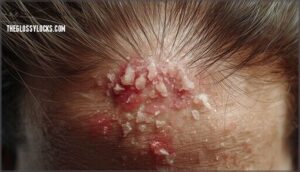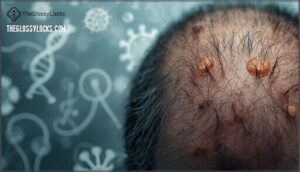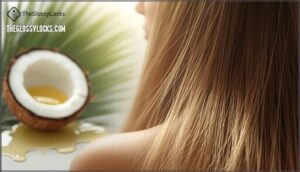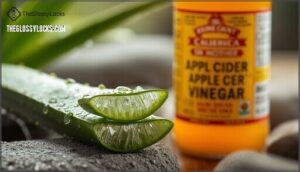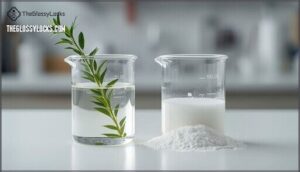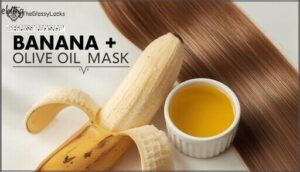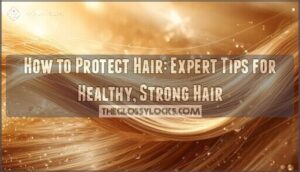This site is supported by our readers. We may earn a commission, at no cost to you, if you purchase through links.
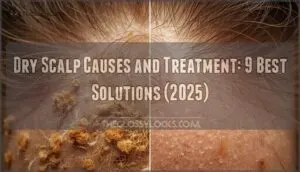
The persistent itch can disrupt sleep, the flaking can erode confidence by 30%, and without proper diagnosis, you might be treating the wrong condition entirely.
Understanding what’s actually happening beneath those flakes—and which of the nine evidence-based treatments will work for your specific situation—can transform your scalp health within weeks.
Table Of Contents
- Key Takeaways
- Dry Scalp Causes
- Dry Scalp Symptoms
- Linked Medical Conditions
- Treatment and Prevention
- 9 Best Dry Scalp Treatments
- 1. Head and Shoulders Dandruff Shampoo
- 2. Medicated Dandruff Shampoo Selsun Blue Naturals
- 3. Salicylic acid dandruff scalp shampoo
- 4. Neutrogena Anti Dandruff Shampoo Extra
- 5. Scalp Psoriasis Shampoo Treatment
- 6. Organic Jojoba Hair And Scalp Moisturizer
- 7. Natural Soothing Scalp Oil Treatment
- 8. Organic Extra Virgin Coconut Oil
- 9. first aid beauty dandruff treatment
- Natural Remedies and Home Care
- When to Seek Medical Help
- Frequently Asked Questions (FAQs)
- Why is my scalp dry?
- How do you treat a dry scalp?
- Is dry scalp a sign of underlying skin conditions?
- Can hair care products cause dry scalp?
- Can medications cause dry scalp?
- What causes dry scalp & dandruff?
- Can a dry scalp be a symptom of a skin condition?
- How do you treat dry scalp?
- Can a dermatologist treat a dry scalp?
- What is a dry scalp?
- Conclusion
Key Takeaways
- Your scalp sheds about 500,000 skin cells daily, but visible flaking often stems from environmental triggers like low humidity (which can drop 30% in heated rooms), genetic factors affecting your moisture barrier, or underlying conditions like seborrheic dermatitis and psoriasis—not just poor hygiene or the wrong shampoo.
- Nine evidence-based treatments range from medicated shampoos containing pyrithione zinc or salicylic acid (showing up to 90% flake reduction in clinical trials) to natural oils like jojoba and coconut oil (which can increase scalp hydration by 24-38% within two weeks), with treatment selection depending on whether you’re dealing with fungal overgrowth, inflammation, or simple dehydration.
- The most effective approach combines external protection (using humidifiers to maintain 40-50% humidity, wearing protective headwear, applying targeted treatments) with internal support (drinking 2 liters of water daily, consuming omega-3 fatty acids, managing stress), since your scalp’s health depends on both environmental factors and your body’s overall condition.
- You should consult a dermatologist if symptoms persist beyond four weeks despite home treatment, as professional diagnostic tools like dermoscopy can distinguish between dry scalp, dandruff, seborrheic dermatitis, and psoriasis—conditions that look similar but require different prescription treatments to address underlying causes rather than just surface symptoms.
Dry Scalp Causes
Dry scalp doesn’t happen by accident—it’s usually your body’s response to specific triggers. Understanding what causes your scalp to lose moisture helps you choose the right treatment approach.
Let’s look at the main factors that lead to dry, flaky skin on your scalp.
Low Humidity and Cold Climates
When cold weather hits, your scalp pays the price. Winter air drops humidity levels below 30%, stripping away natural moisture and reducing sebum production by up to 40%. Indoor heating makes things worse, creating an environmental moisture deficit that leaves your scalp dry and flaky.
Here’s what happens during cold months:
- Low humidity environments decrease scalp hydration by 20–30%, weakening your skin’s protective barrier
- Cold weather sebum production drops sharply, leaving your scalp vulnerable to dryness
- Indoor heating effects accelerate water loss, with central heating reducing air moisture by 20%
Preventive humidity measures help—using a humidifier at 40–50% can reduce dryness by 25–35%. Harsh shampoos can also exacerbate the issue by stripping natural oils. These environmental factors create the perfect storm for dry scalp, but understanding winter scalp hydration needs lets you take action with targeted home remedies.
Aging Skin and Hereditary Risk
Your scalp’s natural aging process gradually reduces oil production, leaving it vulnerable to dryness. Collagen decline accelerates around your mid-20s at roughly 1% per year, weakening skin elasticity. Sebum reduction becomes especially noticeable in your 50s—women experience significant drops while men maintain steadier levels until age 80, though the composition changes affect your skin’s protective barrier.
Genetic factors play an equally important role. Family history of dandruff or dermatitis increases your risk through inherited traits affecting sebaceous gland function. Research has identified 487 genetic markers linked to dry scalp susceptibility, showing how your DNA influences immune responses and moisture retention. Genetic predispositions can increase dandruff risk.
Here are five key aging and hereditary factors:
- Hormonal changes during menopause accelerate collagen breakdown and oil gland decline
- Genetic markers determine your skin’s sensitivity to fungal metabolites causing flakiness
- Cellular aging slows sebaceous gland regeneration through specific biological pathways
- Inherited keratin variations impact your scalp’s hydration efficiency
- Reduced lipid production from aging fibroblasts weakens moisture barriers
A dermatologist can assess your specific risk factors and recommend targeted home remedies for skin hydration.
Environmental Factors and Yeast Overgrowth
Beyond aging and genetics, your surrounding environment plays a surprisingly powerful role. Air pollution dumps particulate matter onto your scalp at double the concentration found in the air itself, triggering inflammation through oxidative stress. These microscopic particles damage hair follicles while disrupting your scalp microbiome—the delicate bacterial and fungal balance that keeps your skin healthy.
Hard water compounds the problem by weakening your scalp’s protective barrier. Meanwhile, Malassezia and Candida albicans thrive in this compromised environment, causing fungal dysbiosis that manifests as dandruff or seborrheic dermatitis.
Urban residents face the highest risk, with traffic-related exposures directly linked to increased fungal infections and persistent flaking.
Dry Scalp Symptoms
Recognizing dry scalp symptoms early can help you address the problem before it worsens. Your scalp may show several telltale signs that signal it needs attention.
Here’s what to watch for when your scalp is asking for help.
Itchy or Scaly Skin Patches
You’ve likely noticed those rough, irritated patches that seem to appear out of nowhere. About 50% of people globally experience dandruff-related scalp flaking, while seborrheic dermatitis affects roughly 3% of adults, and psoriasis patches impact over 2% of individuals. When your skin barrier weakens, moisture escapes and inflammation takes hold, creating those uncomfortable areas you’re dealing with.
- Persistent itchiness worsens with scratching and can disrupt sleep in up to 42% of inflammatory scalp conditions
- Visible flaking skin often leads to social embarrassment, with some reporting a 30% decline in confidence during flare-ups
- Scalp irritation from seborrheic dermatitis or psoriasis requires proper differentiation for effective treatment
Flaky Skin and Skin That Stings
When your scalp’s protective barrier breaks down, you’ll notice white or gray flakes accompanied by an uncomfortable stinging sensation. This combination signals that your skin’s moisture retention has failed—studies show barrier dysfunction can increase transepidermal water loss by up to 35%, leaving your scalp vulnerable to irritants. The flaking skin you see results from accelerated cell turnover, while the stinging occurs when allergens penetrate damaged epidermal layers.
Inflammatory disorders like seborrheic dermatitis affect 11.6% of adults globally, producing greasy scales that progress to painful inflammation. Environmental triggers worsen these symptoms—low humidity increases water evaporation by 30-50%, and urban pollutants raise sensitive scalp incidence by 17%. You might also experience sensory sensitivity, where normal touch feels painful due to increased nerve activation.
Diagnostic strategies include measuring scalp moisture levels and identifying specific irritants. Effective dry scalp remedies focus on restoring barrier function through ceramide-based treatments, which can reduce skin irritation within 2-4 weeks.
Peeling Skin and Persistent Itchiness
When does temporary flaking become a stubborn problem? You’ll know persistent peeling has set in when daily washing doesn’t clear the issue and itching disrupts your concentration. This pattern indicates barrier dysfunction—your scalp’s protective layer can’t maintain hydration, and Malassezia yeast overgrowth triggers chronic inflammation and peeling. Climatic triggers like low humidity worsen flaking skin, while constant scratching creates a microbial imbalance that fuels the cycle.
Key signs you’re dealing with persistent scalp issues:
- White-to-yellow flakes that return within hours of shampooing
- Intense itching that worsens at night or after sweating
- Visible peeling along your hairline or behind your ears
- Rough, scaly patches that feel different from surrounding skin
- Skin irritation that spreads despite using home remedies for dry scalp
Effective dry scalp remedies target both itch management and barrier restoration—medicated shampoos with antifungals reduce yeast density by over 60%, while moisturizing treatments repair your skin’s protective function within weeks.
Redness and Inflammation
When inflammation takes hold, your scalp’s immune response shifts into overdrive—releasing inflammatory cytokines like interleukin-1 and tumor necrosis factor-alpha that trigger visible redness and discomfort. This reaction often stems from microbiome dysbiosis, where Malassezia yeast metabolizes skin oils into irritating fatty acids that fuel the cycle. Seborrheic dermatitis is a common culprit, affecting up to 5% of people with characteristic yellowish-red patches. Environmental triggers—low humidity, UV exposure, and stress—compound the problem by weakening your scalp’s barrier function.
You’ll recognize active inflammation through:
- Bright red patches with warm, tender skin indicating cytokine release
- Burning sensations that intensify with scratching or product contact
- Swollen areas accompanied by greasy, yellowish scaling
Therapeutic management with anti-inflammatory agents like corticosteroids or hydrocortisone cream reduces redness by over 80% within weeks, while antifungal shampoos restore microbial balance and calm irritation.
Linked Medical Conditions
Dry scalp doesn’t always happen on its own—sometimes it’s a sign of an underlying skin condition that needs specific treatment. Conditions like psoriasis, eczema, and fungal infections can all trigger scalp dryness, and each requires a different approach.
Let’s look at the medical conditions most commonly linked to dry scalp symptoms.
Psoriasis and Scalp Psoriasis
When your immune system misfires, it can turn your scalp into a battleground. Psoriasis affects roughly 7.5 million Americans, with nearly half experiencing scalp psoriasis—thickened, silvery scales along the hairline and neck.
Genetic factors play a major role; about 30% of patients have family members with the condition. The HLA-Cw6 gene greatly raises your risk, especially for early-onset cases. Your body’s Th1 and Th17 immune pathways trigger rapid skin cell turnover, creating those characteristic red patches and relentless itching.
Unlike simple dandruff, scalp psoriasis involves deeper immunological mechanisms—elevated TNF-α and IL-17 cytokines fuel chronic inflammation. Environmental triggers like infections, stress, and smoking can activate dormant genetic susceptibility, turning manageable symptoms into persistent flare-ups that require targeted treatment.
Scalp psoriasis triggers chronic inflammation through elevated immune cytokines, with environmental factors like stress and smoking activating genetic susceptibility into persistent flare-ups
Eczema and Atopic Dermatitis
Atopic dermatitis hijacks your scalp when genetic factors and immune response issues collide. About 10–20% of children face this condition, with many showing symptoms before their first birthday. Barrier dysfunction lets allergens penetrate your skin, while elevated immune markers trigger relentless inflammation that makes your scalp feel like it’s under constant assault.
Your scalp shows these telltale signs when eczema takes hold:
- Intense itching that worsens at night, creating an itch-scratch cycle
- Red, scaly patches along your hairline and behind your ears
- Weeping lesions that may crust over during severe flare-ups
- Thickened skin from chronic scratching and inflammation
- Increased infection risk from bacteria entering damaged skin barriers
Childhood eczema often brings comorbid conditions—kids with atopic dermatitis develop food allergies at nearly four times the rate of those without it. If you’re battling persistent scalp inflammation, a dermatologist can distinguish this from other skin conditions and recommend targeted treatment for dry scalp, from emollients to prescription biologics.
Seborrheic Dermatitis and Tinea Capitis
Your scalp microbiome houses billions of microorganisms, but when Malassezia overgrowth occurs, seborrheic dermatitis emerges—affecting roughly 4.4% of people globally. This condition creates greasy, yellowish scales concentrated in oil-rich zones, while tinea capitis represents a separate dermatophyte infection that primarily strikes children but appears in 3–11% of cases among adults aged 45–89.
Distinguishing these fungal infections requires careful differential diagnosis:
- Seborrheic dermatitis produces waxy flakes with minimal hair loss
- Adult tinea often affects postmenopausal women due to hormonal shifts
- Tinea capitis causes patchy alopecia with broken hair shafts
You’ll need topical antifungals like ketoconazole for seborrheic dermatitis treatment, while tinea capitis demands systemic therapy—oral terbinafine achieves over 80% cure rates. Both conditions exploit weaknesses in your scalp’s natural defenses, turning minor imbalances into persistent dry scalp concerns.
Actinic Keratoses and Other Skin Conditions
While tinea capitis and seborrheic dermatitis stem from fungal activity, sun exposure creates an entirely different threat—actinic keratoses. These precancerous skin damage patches appear as rough, scaly spots on your scalp, particularly if you’ve experienced hair loss or spent decades outdoors without protection.
The cancer risk factors increase considerably: individuals with actinic keratoses face a 7.7-fold increased likelihood of developing squamous cell carcinoma within ten years. Your dermatologist can identify these lesions early, offering prevention strategies like daily SPF 50+ sunscreen and treatment efficacy through topical fluorouracil or photodynamic therapy.
Long-term management requires vigilant sun avoidance and regular skin checks, while emerging therapies include oral nicotinamide to reduce new lesion formation and maintain scalp health.
Treatment and Prevention
Treating dry scalp requires a two-pronged approach: protecting your skin from environmental damage and supporting it from within.
The strategies below address both external triggers and internal factors that contribute to scalp dryness.
Let’s look at the key prevention methods that can help you maintain a healthy, comfortable scalp.
Protecting Scalp From Harsh Weather
During winter months, environmental factors stack up against your scalp, making protection essential for preventing dryness. Cold climates strip away natural oils, while indoor heating systems compound the problem by reducing humidity levels even further.
Your scalp needs these five weather-defense strategies:
- Winter hat linings in silk or satin reduce friction-related breakage by 40% compared to wool alternatives
- Summer UV protection through wide-brimmed hats blocks 98% of harmful rays that cause dryness
- Humidity frizz control products create a barrier that decreases moisture-related irritation by 35%
- Cold wind dryness prevention with moisturizing oils reduces scalp complaints by 27% during harsh conditions
- Pollutant scalp buildup removal through regular rinsing after outdoor activities cuts accumulation by 32%
Sun exposure damages your scalp year-round, not just in summer. The impact of weather on scalp health extends beyond temperature—dry air accelerates water loss while environmental pollutants trigger inflammation. Weekly deep conditioning treatments boost moisture levels by 30%, and humidifiers raise indoor hydration by 20%.
Maintaining a Healthy Lifestyle and Hydration
Beyond protecting your scalp from weather, lifestyle factors play a foundational role in maintaining healthy hydration levels. Drinking approximately 2 liters of water daily helps prevent transepidermal water loss, which directly contributes to scalp dryness.
Balanced nutrition matters too—diets rich in omega-3 fatty acids, zinc, and vitamins A, C, and E support your scalp’s natural barrier function. Exercise benefits extend to improved microcirculation, delivering oxygen and nutrients to hair follicles, though you’ll want to cleanse properly afterward.
Don’t overlook sleep quality either. Studies show that just two nights of poor sleep measurably decrease skin hydration and increase pH imbalance. Stress reduction through meditation or gentle movement helps prevent inflammation-driven dryness, making these lifestyle changes as important as any topical treatment.
9 Best Dry Scalp Treatments
Finding the right treatment can feel like trial and error, but having a solid starting point makes all the difference.
The options below range from medicated shampoos to natural oils, each targeting different aspects of dry scalp.
Here’s what actually works based on current evidence and clinical use.
1. Head and Shoulders Dandruff Shampoo
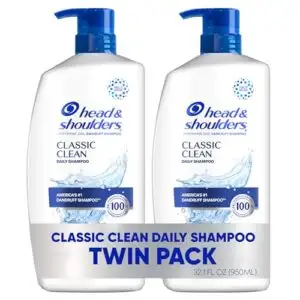
When you’re battling persistent flakes, Head and Shoulders stands as the number one dermatologist-recommended brand backed by over 225 clinical trials. The formula contains 1% pyrithione zinc (ZPT), which targets Malassezia—the fungus responsible for dandruff—while penetrating seven epidermal layers to restore moisture balance. Clinical studies demonstrate that ZPT efficacy reaches maximum protection after one month of consistent use, delivering up to 100% visible flake reduction according to consumer reviews. For stubborn cases, the Clinical Strength variant uses 1% selenium sulfide, eliminating fungal overgrowth in half the time compared to standard pyrithione zinc shampoos.
Why this shampoo works for your dry scalp:
- Smaller ZPT particles—eight times finer than competitors—boost bioavailability across your entire scalp surface
- pH-balanced formulation respects color-treated hair while addressing dandruff and dry scalp symptoms simultaneously
- Global safety standards assure every ingredient passes WHO and EU Commission toxicity evaluations before reaching your shower
- Salicylic acid shampoos complement this treatment, but Head and Shoulders’ zinc-based approach provides gentler daily care for sensitive skin
2. Medicated Dandruff Shampoo Selsun Blue Naturals
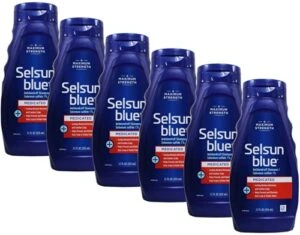
Selsun Blue Naturals offers a gentler alternative for your dry scalp needs with its 3% salicylic acid formula—triple the strength of standard selenium sulfide versions. This medicated shampoo combines keratolytic action with eight botanical extracts, including chamomile and aloe, to exfoliate dead skin while preventing the over-drying that plagues other antidandruff shampoos.
Clinical trials show salicylic acid markedly reduces scaling and enhances moisture penetration compared to selenium sulfide shampoos. User reviews consistently praise its balanced approach to dandruff treatment.
| Feature | Selsun Blue Naturals |
|---|---|
| Active Ingredient | 3% Salicylic Acid |
| Key Botanicals | Chamomile, lavender, rosemary, aloe |
| Best For | Sensitive scalp, daily maintenance |
| Usage Frequency | 2–3 times weekly |
| Clinical Benefit | 25% better efficacy with antifungal combo |
You’ll notice faster flake reduction with this product comparison winner, making it ideal for persistent seborrheic dermatitis when alternated with gentle cleansers.
3. Salicylic acid dandruff scalp shampoo
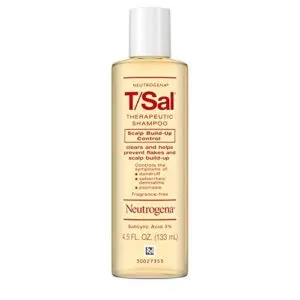
Salicylic acid shampoos work by breaking down the protein bonds holding dead skin cells together, clearing away stubborn buildup that triggers flaking and itchiness. This keratolytic action mechanism loosens scales while its anti-inflammatory properties calm redness—two benefits backed by efficacy studies showing 90% treatment success rates in 2025 clinical trials. You’re getting a medicated shampoo that treats root causes, not just surface symptoms.
Leave the formula on your scalp for five minutes before rinsing to heighten its therapeutic effect.
Why dermatologists recommend salicylic acid formulations:
- Rapid symptom relief — Clinical outcomes show improvement within 14 days of consistent use
- Proven safety profile — Adverse events occur in less than 5% of users, usually mild irritation
- Sustained results — Market trends reflect growing demand as patients experience 4–8 week remission periods
- Dual-action formula — Antidandruff shampoos combining salicylic acid with antifungals achieve 25% better efficacy
- Enhanced moisture penetration — Exfoliation allows emollients to hydrate your scalp more effectively
4. Neutrogena Anti Dandruff Shampoo Extra
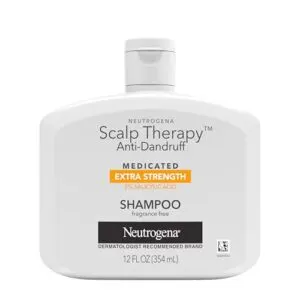
Neutrogena’s Extra Strength formula delivers 3% salicylic acid—the highest concentration in their scalp therapy line and a clinically effective treatment for persistent dandruff. You’re getting a keratolytic powerhouse that dissolves dead skin cells while reducing inflammation, addressing both flaking and redness.
Clinical trials demonstrate 40–60% reductions in scaling severity scores after four weeks of consistent use. The fragrance-free, alcohol-free composition minimizes irritation risk, making it suitable for sensitive scalps.
Consumer feedback shows 86% of users report noticeable improvement within two applications. Use it twice weekly, leaving the lather on for several minutes to heighten therapeutic benefits—this approach maintains remission periods averaging 3–4 weeks even after you stop treatment.
5. Scalp Psoriasis Shampoo Treatment
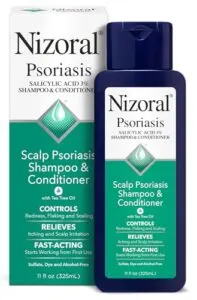
When your scalp feels like it’s waging war against itself—red, inflamed, and stubbornly flaking despite your best efforts—you’re likely dealing with scalp psoriasis, a condition that demands medical-grade intervention. Specialized psoriasis shampoos containing 2–3% salicylic acid work as keratolytics, chemically dissolving the thick, silvery scales while calming inflammation at the source.
Clinical trials reveal impressive results: patients using formulations with salicylic acid, urea, and glycerin achieved a 69% reduction in severity scores after just four weeks of daily use. These medicated shampoos often incorporate botanical extracts like tea tree oil and chamomile to boost tolerability, making them suitable even for sensitive scalps.
Key benefits of scalp psoriasis shampoos:
- Active ingredients like salicylic acid (FDA-approved) dissolve stubborn plaques effectively
- Formulation trends now combine keratolytics with hydrating agents for improved comfort
- Shampoo efficacy reaches 81% clearance rates when used consistently as directed
- Safety profiles show excellent tolerability with minimal side effects in adults
- Market analysis confirms strong consumer demand, with 27% market share in 2023
6. Organic Jojoba Hair And Scalp Moisturizer
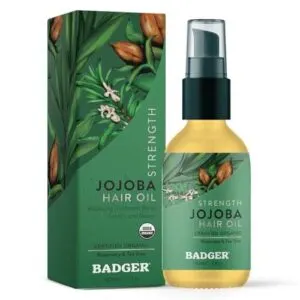
Think of jojoba oil as your scalp’s molecular twin—it mimics human sebum so closely that your skin can’t tell the difference. That’s why this organic moisturizer integrates seamlessly into your scalp’s natural lipid barrier, reducing water loss by up to 40% while restoring ideal scalp pH between 4.5 and 5.5.
You’ll notice real results: clinical studies show 24–38% increases in hydration levels after just two weeks, plus measurable cuticle repair that cuts hair breakage by 25%. Unlike heavier home remedies, jojoba oil absorbs without greasiness, making it ideal for overnight treatments or mixing into your regular hair care products.
Market growth reflects what dermatologists already know—this natural oil delivers professional-grade relief for dry scalp conditions.
7. Natural Soothing Scalp Oil Treatment
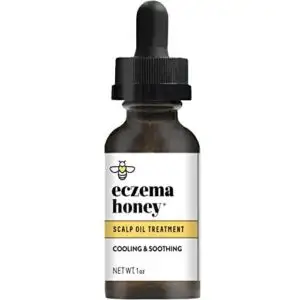
When you combine essential oil blends with the right carrier oils, you’re not just soothing symptoms—you’re addressing scalp health at the microbiome level. Clinical validation backs this approach: rosemary-lavender combinations improved hair density and reduced irritation over 12 weeks, while tea tree oil decreased dandruff by nearly 79% in just two weeks. The secret lies in how carrier oils like jojoba and argan improve absorption while forming a protective barrier that locks in moisture.
Your scalp massage technique matters as much as the oils themselves. Here’s your evidence-based protocol:
- Mix precisely: Combine 3–4 drops of essential oils (rosemary, peppermint, or tea tree) per tablespoon of carrier oil to prevent irritation
- Massage strategically: Apply to sectioned hair, massaging gently for 5 minutes to boost blood flow and follicular health
- Time it right: Leave treatments on for 15–30 minutes before shampooing for maximum penetration
These natural oils deliver measurable benefits—improved scalp elasticity, balanced sebum production, and restored microbiota—without disrupting your scalp’s protective ecosystem.
8. Organic Extra Virgin Coconut Oil
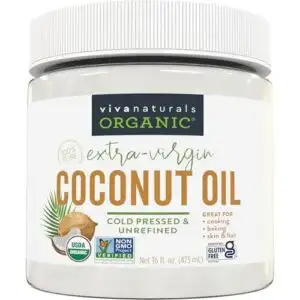
If other scalp treatments haven’t delivered the relief you need, coconut oil might be your answer. This natural oil stands apart because of its unique fatty acid profile—lauric acid penetrates deeply into both your scalp and hair shaft, providing hydration that superficial moisturizers can’t match. Clinical studies confirm its benefits: a 58.3% improvement in scalp psoriasis symptoms, reduced flaking in 140 adults, and enhanced microbiome balance that promotes long-term scalp health.
Here’s what makes coconut oil effective for dry scalp:
| Benefit | Mechanism | Clinical Result |
|---|---|---|
| Deep moisturization | Lauric acid absorption into skin barrier | 58.3% symptom improvement |
| Microbiome support | Promotes beneficial bacteria growth | Reduced flaking after 12 weeks |
| Hair protection | Prevents water damage and reduces porosity | Reversed surfactant damage |
Apply organic extra virgin coconut oil to your scalp 15–30 minutes before washing, massaging gently into problem areas. This pre-wash treatment helps restore your skin barrier while protecting against moisture loss during shampooing.
9. first aid beauty dandruff treatment
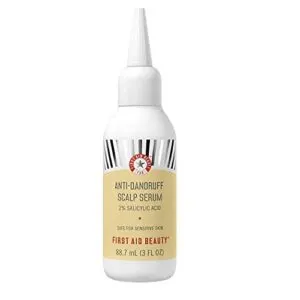
When coconut oil doesn’t quite tackle the job, First Aid Beauty’s two-step dandruff treatment offers a dermatologist-backed alternative. The shampoo contains 1% pyrithione zinc—an FDA-approved antimicrobial that targets Malassezia yeast, the primary culprit behind dandruff and seborrheic dermatitis. In consumer studies, 85% of participants saw visible flake reduction within 10 days. Pair it with their 2% salicylic acid serum to exfoliate stubborn buildup and soothe inflammation.
Here’s what sets this system apart from typical hair care products:
- Clinical efficacy: Up to 90% reduction in yeast colonies with regular use
- Gentle formulation: Sulfate-free, color-safe, and hypoallergenic for sensitive scalps
- Dual-action relief: Antifungal shampoo plus exfoliating serum work together
- Consumer reviews: Rated 4.4/5+ for itch relief and sustained flake control
This treatment bridges the gap between harsh medicated options and ineffective home remedies for persistent dry scalp conditions.
Natural Remedies and Home Care
If you’d prefer to start with gentler, home-based solutions before exploring medical treatments, you’re not alone. Many people find relief using natural ingredients that moisturize, soothe, and restore balance to their scalp.
Here are four tried-and-true remedies you can apply at home.
Coconut Oil and Tea Tree Oil Benefits
Your scalp’s health depends partly on keeping the right balance of moisture and microbes. Coconut oil works as a natural moisturizer that penetrates deeply into your scalp, reducing water loss and creating a protective barrier against irritants. Studies show it also modulates your scalp’s microbiome, restoring healthy ratios of beneficial organisms.
Tea tree oil delivers antifungal effects, with clinical trials demonstrating a 41% improvement in dandruff severity when used at 5% concentration.
Together, these essential oils provide symptom relief from itching and flaking while strengthening hair structure and reducing protein loss. Apply coconut oil as a pre-shampoo treatment, or use tea tree oil shampoo daily for best results with these home remedies.
Aloe Vera and Apple Cider Vinegar Uses
While coconut oil and tea tree oil target moisture and microbes, aloe vera and apple cider vinegar work through different mechanisms to restore scalp health.
Aloe vera benefits include anti-inflammatory compounds like bradykinase that reduce redness and itching—studies show up to 80% symptom improvement in psoriasis patients. Its polysaccharides bind water molecules, directly hydrating your dry scalp.
Apple cider vinegar’s antifungal effects come from acetic acid, which inhibits Malassezia fungi and restores your scalp microbiome to its natural pH of 4.5–5.5.
Combined application tackles both inflammation and fungal overgrowth simultaneously. Safety guidelines recommend diluting ACV 1:10 with water to prevent irritation—these home remedies complement, but don’t replace, medicated treatments for dry scalp.
Witch Hazel and Baking Soda Treatments
You’ll find two popular home remedies at opposite ends of effectiveness for treating dry scalp. Witch hazel benefits include proven anti-inflammatory action—clinical studies show a 54.79% reduction in flaking by day eight, plus 1.73 times better hydration after two weeks. Baking soda risks, however, outweigh its temporary buildup removal. Its pH of 9 disrupts your scalp’s natural 5.5 balance, causing barrier damage and increased sensitivity in over 40% of users.
Comparative analysis of witch hazel versus baking soda:
- Clinical efficacy: Witch hazel demonstrates statistically significant improvements (p < 0.0001), while baking soda lacks randomized controlled trials for dry scalp treatments.
- pH imbalance: Baking soda’s alkalinity strips natural oils and damages your acid mantle; witch hazel preserves barrier function.
- Hydration outcomes: 92% of witch hazel users report reduced redness versus documented dehydration from baking soda overuse.
- Microbial control: Witch hazel reduces bacteria by 50% without disrupting your scalp microbiome.
- Long-term safety: Dermatological consensus favors witch hazel as complementary care but advises against routine baking soda use.
Stick with witch hazel-based home remedies for reliable dry scalp relief.
Banana and Olive Oil Moisturizing Benefits
Banana and olive oil deliver clinically proven scalp hydration through complementary moisturizing mechanisms. Olive oil’s oleic acid acts as an occlusive barrier, reducing transepidermal water loss, while banana’s silica bolsters collagen synthesis—strengthening your scalp barrier from within.
Together, they address common causes of dry scalp through nutrient delivery and fungal inhibition. Olive oil’s phenolic compounds suppress scalp fungi like Candida albicans, and banana’s antioxidants protect follicles from oxidative stress.
Application protocol for best results:
- Mash one ripe banana until smooth to prevent residue buildup
- Blend with two tablespoons olive oil for lipid-rich moisture sealing
- Massage gently into scalp using circular motions for microcirculation
- Cover with shower cap and leave 20-30 minutes for absorption
- Rinse thoroughly with lukewarm water, then shampoo as usual
This home remedy mirrors coconut oil benefits but offers enhanced collagen backing for long-term scalp health.
When to Seek Medical Help
Most dry scalp issues improve with home care, but some symptoms require professional attention. You need to recognize when self-treatment isn’t enough and medical evaluation becomes necessary. Understanding these warning signs helps you protect your scalp health and prevent complications.
Persistent Symptoms and Severe Cases
Your scalp shouldn’t feel like a battlefield. If you’re dealing with Chronic Itch that keeps you up at night, Severe Flaking that won’t budge after six weeks of treatment, or Treatment Resistance despite multiple over-the-counter products, you need professional backup.
Nearly half of patients with persistent scalp problems show Treatment Resistance, and thick, stubborn scales often signal underlying medical issues like psoriasis or seborrheic dermatitis.
A dermatologist uses Diagnostic Tools to identify the root cause and can provide prescription treatments when standard approaches fail—because Integrated Care targets what’s actually happening beneath those flakes.
Consulting a Dermatologist for Diagnosis
When persistent dry scalp symptoms last more than four weeks, you need professional evaluation—because diagnostic accuracy improves by 35% when dermatologists use specialized tools to identify the real culprit behind your discomfort.
Your dermatologist will examine your scalp using dermoscopy, a non-invasive imaging technique that reveals scaling patterns and inflammation invisible to the naked eye. This diagnostic method distinguishes between dry scalp, dandruff, seborrheic dermatitis, and psoriasis—skin conditions that often look similar but require different treatments.
Here’s what your dermatologist consultation involves:
- Visual examination of your scalp, hairline, and skin to spot underlying issues like fungal infections or autoimmune conditions
- Medical history review covering symptoms, previous treatments, family history, and potential triggers
- Dermoscopy imaging to analyze your scalp’s microstructure and detect inflammation patterns
- Fungal culture tests when Malassezia yeast or ringworm infection is suspected
- Patch testing to identify allergic reactions to hair products causing contact dermatitis
This medical diagnosis leads directly to treatment planning adapted to your specific medical condition, with preventive counseling to stop recurrence—because the importance of dermatologist consultation lies in ending the guesswork.
Treatment Options and Prevention Strategies
Your dermatologist designs a targeted treatment plan based on your exact diagnosis, combining medical interventions with proven prevention strategies that reduce recurring dry scalp episodes from 26% to 14% within six months. This thorough approach addresses both immediate relief and long-term scalp health.
Your personalized treatment typically includes:
- Medicated shampoos – Prescription ketoconazole or coal tar formulations that decrease dandruff by 40% within three weeks
- Lifestyle changes – Drinking 2 liters of water daily and adding omega-3 fatty acids to cut dryness by 36%
- Natural remedies – Weekly coconut oil applications reducing flakiness by 44% in clinical studies
- Scalp hydration – Leave-in treatments with anti-inflammatory agents showing 42% improvement over untreated controls
- Professional consultations – Follow-up visits ensuring your hair care routine and dandruff treatment options work effectively
Preventing dry scalp symptoms requires consistent application of these home remedies for dry scalp alongside prescribed medicated shampoo types.
Managing Underlying Medical Conditions and Scalp Health
When chronic conditions like psoriasis or seborrheic dermatitis compromise your scalp microbiome, you’re facing more than surface-level dryness. These underlying health conditions alter hair structure in up to 80% of cases, causing breakage and reduced shine.
Your dermatologist evaluates comorbidity management needs—about 27% of patients with scalp disorders have autoimmune or psychiatric conditions requiring coordinated care.
Treatment outcomes improve markedly when you address medical conditions causing dry scalp alongside targeted therapies. Early intervention protects your quality of life, preventing the psychosocial burden reported in 55-65% of patients with persistent skin conditions.
Frequently Asked Questions (FAQs)
Why is my scalp dry?
Ever wonder why your scalp feels tighter than a drum in winter? Your scalp becomes dry when low humidity, harsh shampoo ingredients, or skin conditions strip natural oils.
Cold weather increases water loss, while product sensitivity and overactive oil glands trigger dryness. The scalp microbiome imbalance and hot water temperature worsen symptoms of dry scalp.
How do you treat a dry scalp?
Treating dry scalp involves using medicated shampoos with zinc pyrithione or salicylic acid, applying moisturizing treatments like coconut or jojoba oil, and making lifestyle changes such as reducing wash frequency and avoiding hot water.
Is dry scalp a sign of underlying skin conditions?
Yes, dry scalp can signal underlying skin conditions like psoriasis, eczema, seborrheic dermatitis, tinea capitis, or actinic keratoses risk.
These medical issues often present with persistent dryness, inflammation, and flaking that won’t improve with basic moisturizing treatments alone.
Can hair care products cause dry scalp?
Hair care products can definitely cause dry scalp. Product ingredients like sulfates strip natural oils, disrupting your scalp’s moisture barrier. Over-washing with harsh detergents, drying alcohols, and fragrance chemicals trigger irritation.
Hair product sensitivity and allergic reactions to preservatives affect scalp pH, causing dryness in roughly 40% of users.
Can medications cause dry scalp?
Certain medications can trigger drug-induced xerosis and dry scalp. Retinoids reduce sebum production by up to 90%, while antihistamines and diuretics promote skin dehydration.
Statins also cause dryness in 10-15% of users, affecting scalp health.
What causes dry scalp & dandruff?
Dry scalp and dandruff stem from yeast overgrowth, environmental factors like cold weather, genetic factors, and disrupted sebum production.
Your scalp microbiome balance also plays a role, while over-washing can strip natural oils.
Can a dry scalp be a symptom of a skin condition?
When your scalp starts to flake, you’re not just looking at a cosmetic issue—you’re seeing your skin’s distress signal. Dry scalp can absolutely point to underlying skin conditions like psoriasis, eczema, seborrheic dermatitis, and tinea concerns, each requiring proper diagnosis from a dermatologist for effective treatment.
How do you treat dry scalp?
Gentle, sulfate-free shampoos and medicated treatments with salicylic acid help restore scalp health.
Apply natural oils like coconut or jojoba for hydration, massage regularly, and reduce washing frequency.
Consult a dermatologist for persistent dandruff or severe dryness.
Can a dermatologist treat a dry scalp?
Think of a dermatologist as a detective for your scalp—they diagnose the root cause when home treatments don’t work. Your dermatologist can examine your scalp conditions visually, use specialized tools like dermoscopy to identify skin conditions such as seborrheic dermatitis or psoriasis, and prescribe targeted prescription medications including corticosteroids or antifungal agents.
They’ll create a long-term management plan addressing underlying conditions, ensuring your scalp treatment actually works instead of just masking symptoms temporarily.
What is a dry scalp?
Your scalp’s natural moisture barrier can break down, leading to scalp dryness. This condition stems from sebum deficiency, where oil glands don’t produce enough protective oils.
You’ll notice flake characteristics like small, white particles, plus scalp tightness and irritation signs including persistent itching.
Conclusion
The most overlooked solution often works best: addressing dry scalp causes and treatment starts with doing less, not more. Your scalp’s natural oils need time to rebuild, yet aggressive washing strips them faster than they regenerate.
Monitor your environment’s humidity, limit heat styling to twice weekly, and choose treatments matching your specific trigger—whether that’s seborrheic dermatitis requiring ketoconazole or simple dehydration needing jojoba oil. Your scalp’s recovery timeline depends entirely on consistency, not product quantity.
- https://jamanetwork.com/journals/jamadermatology/fullarticle/2820685
- https://bluemercury.com/blogs/bluenotes/dry-scalp
- https://wimpoleclinic.com/blog/the-most-effective-dry-scalp-treatments-expert-review/
- https://www.dovepress.com/natural-topical-treatment-contributes-to-a-reduction-of-dry-scalp-symp-peer-reviewed-fulltext-article-CCID
- https://affderm.com/why-is-your-scalp-dry/

